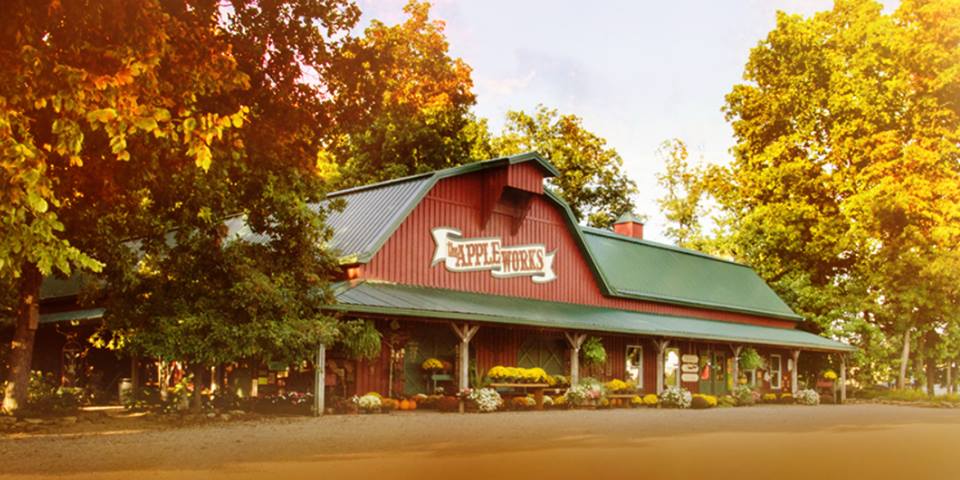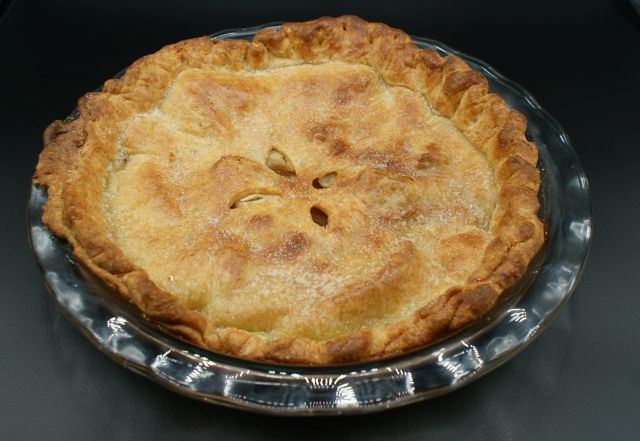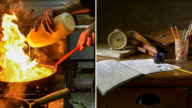A Brief History of Apple Pie
“As American as apple pie” is a well-worn phrase that reflects our recent cultural memory, but ignores the European tradition of pie making. In our Guidebook, “1,000 Foods to Eat Before You Die”, Mimi Sheraton writes that “England’s centuries-long history of meat and fruit pies is undoubtedly the inspiration behind this most American passion” (page 521). Her assertion is borne out by a simple recipe found in “A Proper New Booke of Cookery”, published in London in 1575. (Don’t be alarmed by the reference to coffins – that was the term used for pie crusts, back in the day.)
To make pies of greene Apples.
Take your Apples and pare them
cleane, and core them as ye wil a quince
then make your coffin after this manner,
take a litle fayre water, and halfe
a fishe of butter, and a litle Saffron,
and set all this upon a chafindyshe, tyll
it bee hote, than temper your flower
with this sayd licour, and the white of
two egges, & also make your coffin and
season your Apples with Cinamon,
Ginger and Sugar inough. Then put
them into your coffin, and bake them.
Finding the Right Apples
On a recent October afternoon, Mary and I set out to get the key ingredient for an apple pie – the apples. We made the 30 minute drive to The Apple Works in Trafalgar, Indiana. This orchard raises over 50 varieties of apples on 9,000 trees. They also grow blackberries, pears, winter squash, and, in the summer, have a large greenhouse full of flowering plants.

Oh, and they grow pumpkins, too. They’ll let you pick them yourself, right out of the patch, which is what several dozen families were doing that day. It was two weeks before Halloween and the place was packed at 5pm on a weekday. There were small children everywhere, accompanied by older siblings, parents, grandparents, aunts, uncles and other assorted adults. The place had the happy, chaotic feel of a grade school field trip.
We avoided the General Store, which had a line of shoppers out the door, and found a side door in the big red barn that led to a large room with rows of neatly stacked cardboard boxes filled with apples. There were dozens of varieties on display in open cases on top of each stack. Several employees were there to advise us on the different apples, and to provide samples – sliced just for us.
Mimi’s recipe called for Cortland or Northern Spy apples. Neither of these were available, but the woman waiting on us suggested Melrose apples. We each tried a slice and agreed they would make a good pie – not too tart or too sweet.
Cheese or Ice Cream on Top?
Any conversation among apple pie fans invariably includes a discussion (often turning into a debate) of the merits of topping the pie with a slice of cheese versus a scoop of vanilla ice cream. Mary and I were raised in the South, where “pie a la mode” – a hot slice of pie with ice cream melting on top – was the only choice on the menu. We didn’t learn about the cheese option until we moved further north heard our friends ask for cheese when they were offered pie.
Mimi’s recipe allows for “a savory, decadent choice” – replacing half of the butter in the crust with cheddar cheese. This allows for the possibility of having the best of both worlds. She notes that the best flavors of ice cream to pair with this pie would be vanilla or cinnamon. She also comments that “for purists, the pie needs no enhancement”.
Two Tastings

We took the pie, fresh from the oven, to a meeting of our book club. Our club meeting in October is usually held outdoors, around the backyard fire pit at the home of our friends April and Todd. This was a great setting to enjoy the pie, but it didn’t lend itself to a careful tasting. (It was dark outside, and wine and conversation were both flowing.)
We made it home with two pieces of pie, which were delicious when we reheated them the following night. The apple filling was just right – the apples retained their flavor and texture and were suspended in a sweet glaze with a hint of cinnamon. Mary commented that the cheese flavor in the crust was very subtle. She was right – sometimes you tasted it, sometimes not. I thought it tasted a little like a Cheez It cracker.
And I didn’t miss the ice cream!
So whether you like your pie with cheese on top or with ice cream, this recipe is worth trying. Just remember to bake it “tyll it bee hote”!
The Recipe
From “1,000 Foods to Eat Before You Die”, by Mimi Sheraton, pp. 522 – 523.
Makes one double-crust, 9-inch pie; serves 6.
For the pastry:
- 4 ounces sharp, aged Cheddar cheese, preferably white
- 8 tablespoons (1 stick) cold, unsalted butter
- 1 3/4 cups sifted all-purpose flour, as needed
- 1/2 teaspoon salt
- 1/4 teaspoon mace
- 5 to 6 tablespoons ice water
For the filling:
- large apples (about 2 pounds), preferably Cortland or Northern Spy (note: we used Melrose and got great results)
- 2 to 3 tablespoons lemon juice
- 2/3 cup sugar
- Pinch of salt
- 1/2 teaspoon cinnamon
- 1/4 teaspoon freshly grated nutmeg
- About 1 tablespoon butter, cut into tiny pieces
- 1 large egg yolk
- 2 tablespoons milk
- Make the pastry: Place the cheese in a food processor, and grate it to a fine meal; you should have about 1 cup loosely packed cheese. Cut the butter into small pieces.
- Measure out 1 2/3 cups of sifted flour and resift it with the salt and mace into the food processor. Add the grated cheese and butter and process until the mixture has the texture of fine meal.
- Slowly trickle in the ice water, 2 tablespoons at a time, processing between each addition, until the dough leaves the sides of the bowl and forms a ball. If the dough seems too sticky, add more flour 1 tablespoon at a time; if it is too dry and crumbly, add more water 1 tablespoon at a time.
- Place the dough on a lightly floured pastry board and divide it in half. Form each half into a ball and lightly knead each once or twice with the palm of your hand to firm up the dough. Reshape each half into a ball and flatten them slightly into thick disks. Wrap each with plastic wrap or wax paper and chill for at least 1 hour, but preferably for 3 or 4 hours, or even overnight.
- About 10 minutes before rolling out the dough, remove it from the refrigerator and let it warm up a bit. Roll out each disk of dough on a lightly floured surface to a thickness of 1/4 inch. One round of rolled dough should be fitted into the bottom of an ungreased 9-inch pie pan, leaving extra hanging over. Roll out the second sheet of dough and drape it, untrimmed, over the lined pie pan. Cover the dough snugly with was paper or plastic wrap and refrigerate the pie pan and dough while you prepare the apples.
- Preheat the oven to 425 degrees F.
- Make the filling: Peel and core the apples and slice them vertically to 1/8- to- 1/4 inch thickness. Place them in a large bowl. Sprinkle the apples with a little lemon juice as you slice, to prevent discoloration.
- Toss the apples with the sugar, salt, cinnamon and nutmeg.
- Remove the pie pan from the refrigerator and gently lift the top crust from the pan. Arrange a flat layer of apples that completely covers the bottom pie crust. Then heap the remaining apple slices on top and level them. Dot the apples evenly with the pieces of butter.
- Fill the top pie crust over the apples, trimming the edges to just cover the rim of the pie pan and crimping them to the bottom crust with the tines of a fork dipped in cold water.
- Bake the pie for 15 minutes, then reduce the heat to 350 degrees F. Bake until the top crust begins to turn a light golden brown, another 25 minutes.
- Beat the egg yolk with the milk in a small bowl. Remove the pie from the oven and brush the mixture all over the top crust. Sprinkle the crust liberally with sugar and return the pie to the oven until the edges of the pie are deep golden brown, another 10 to 15 minutes. Serve warm or cold.


Apple pie with cheese?! I didn’t know this was a “thing”! I grew up in Ohio and the only thing served with apple pie was ice cream (homemade by the noisiest machine ever). I now know how to make vanilla ice cream in a Ziploc baggie in about 10 mins flat, MUCH easier!
I love the wording (and spelling) from the 1575(!) “cookery booke,” and I’m REALLY glad you explained about coffin; elsewise, putting the apple mixture in your coffin takes on a whole different meaning! 😳 Thanks for another great and interesting story/recipe, you two. (Now I just need to google what a “chafindyshe” might be…🤔)
Save a piece for me, When I was a boy we often had cheese with apple pie.
I spent a week with my grandmother in NYC when I was 8. My grandmother, who was trained as interior designer and journalist in France, was going fabric shopping. It was deadly boring with two exceptions: we went to the Bronx Zoo and I got to see the movie Dr Doolittle at Radio City Hall. And one afternoon she took me somewhere (wish I could remember the name) to eat apple pie with hard sauce. It isn’t that the pie was so outstanding to an 8 year old but I was just old enough to be puzzled by “hard sauce”. That seemed such an oxymoron. I’ve googled hard sauce and it is butter based and boozy. Your post brought all those memories back. Lovely piece!